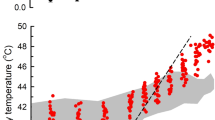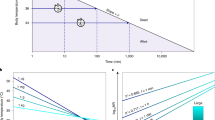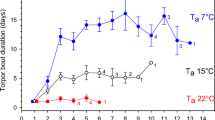Abstract
IN cold climates, enhanced fur insulation gives larger mammals sufficient cold resistance1 to lower the temperature tolerance limits by approximately 35° C (ref. 2). In smaller mammals such as mice, lemming, red squirrel, muskrat and hare, winter changes in pelage are much smaller3, and it has been concluded that “unless these species entirely escaped exposure to winter cold, they must largely rely on their ability to change heat production”3. An increased ability to survive in the cold as a result of an enhanced capability for producing heat has in fact been demonstrated in deer mice4 and wild rats5.
This is a preview of subscription content, access via your institution
Access options
Subscribe to this journal
Receive 51 print issues and online access
$199.00 per year
only $3.90 per issue
Buy this article
- Purchase on Springer Link
- Instant access to full article PDF
Prices may be subject to local taxes which are calculated during checkout
Similar content being viewed by others
References
Irving, L., Krog, H., and Monson, M., Physiol. Zool., 28, 173 (1955).
Hart, J. S., Rev. Canad. Biol., 16, 133 (1957).
Hart, J. S., Canad. J. Zool., 34, 53 (1956).
Hart, J. S., and Héroux, O., Canad. J. Zool., 31, 528 (1953).
Hart, J. S., and Héroux, O., Canad. J. Zool., 41, 711 (1963).
Hart, J. S., Fed. Proc., 17, 1045 (1958).
Héroux, O., Rev. Canad. Biol., 20, 55 (1961).
Chevillard, L., and Bertin, R., CR Soc. Biol., 159, 341 (1965).
Hannon, J. P., and Young, D. W., Amer. J. Physiol., 197, 1008 (1959).
Sellers, E. A., and You, R. W., Brit. Med. J., 1, 815 (1956).
Sellers, E. A., and Baker, D. G., Canad. Med. Assoc. J., 83, 6 (1960).
Gilson, S. B., Amer. J. Physiol., 161, 87 (1950).
Héroux, O., and Campbell, J. S., Lab. Inv., 9, 305 (1960).
Dugal, L. P., Saucier, G., and Perrault, M., Proc. XVth Cong. Zool., Sect. VI, Paper 28 (1958).
Hart, J. S., Symp. Soc. Exp. Biol., 18, 31 (1964).
Héroux, O., Proc. Third Midwest Conf. on the Thyroid, 21 (Univ. of Missouri, Columbia, 1967).
Héroux, O., and Schönbaum, E., Canad. J. Biochem. Physiol., 37, 1255 (1959).
Héroux, O., Canad. J. Physiol. Pharmacol., 46, 843 (1968).
Magwood, S. G. A., and Héroux, O., Canad. J. Physiol. Pharmacol., 46, 601 (1967).
Héroux, O., and Petrovic, V., Canad. J. Physiol. Pharmacol., 47, 963 (1969).
Héroux, O., Fed. Proc., 28, 955 (1969).
Author information
Authors and Affiliations
Rights and permissions
About this article
Cite this article
HÉROUX, O. Pathological Consequences of Artificial Cold Acclimatization. Nature 227, 88–89 (1970). https://doi.org/10.1038/227088a0
Received:
Revised:
Issue Date:
DOI: https://doi.org/10.1038/227088a0
This article is cited by
-
Developmental and adult acclimation effects of ambient temperature on temperature regulation of mice selected for high and low levels of nest-building
Journal of Comparative Physiology ? B (1978)
-
Seasonal changes in thermogenesis, organ weights, and body composition in the white-footed mouse,Peromyscus leucopus
Oecologia (1973)
Comments
By submitting a comment you agree to abide by our Terms and Community Guidelines. If you find something abusive or that does not comply with our terms or guidelines please flag it as inappropriate.



